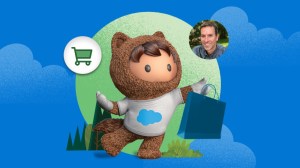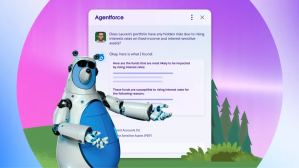Salesforce’s 2022 Cyber Week report, out now, analyzes data from over 1.5 billion shoppers to highlight what’s happening in the marketplace.
The data shows a unique holiday season well under way — one where retailers and consumers alike are feeling the impact of a tough economic climate, but also seeing signs of strong consumer demand. In fact, Black Friday shopping was record-breaking, with Commerce Cloud sales growth of 14% year over year.
To really understand the factors at play, it helps to have insights from an expert like Rob Garf. Colloquially known as “Retail Rob,” Garf is VP and GM of Retail at Salesforce. In this interview, he peels back the wrapping paper for a look at what’s driving 2022 holiday retail trends — from automation to productivity.
Q. What are the unique trends affecting retailers this holiday season?
Retailers are facing unprecedented costs of doing business, which has worked its way into the cost of goods sold and increased prices for consumers. Last year, retailers were able to absorb much of those costs, partly because they passed them on to suppliers. They were also able to avoid having to sell items at discounts because there was a combination of heavy demand and inventory scarcity.
But this year, everything has turned against them from a cost perspective. From energy, to transportation, to packaging, to cost of raw materials, to wages, costs have increased significantly. They’re forced to pass these expenses on to consumers, and they must absorb some themselves, which puts tremendous margin pressure on retailers and their businesses.
Q. With these economic headwinds, what are some of the top things retailers should do to drive success now?
To look ahead, we should first look back at how consumer loyalty has changed. In 2020, it was all about health, safety, convenience, and trust. There was a huge emphasis on removing friction from the shopping process. This meant facilitating buying products from the comfort and safety of home, and making sure that a product was actually available, whether that was in or around the store, or delivered to a consumer’s doorstep.
Retailers became scrappy. Now it’s all about scale. They have to find ways to automate the fulfillment process. They must also find ways to increase productivity in the physical store, especially as the store’s impact grows and influences digital sales. In fact, according to our State of Sales report, 60% of digital sales are influenced by the physical store, whether demand is being generated or demand is being fulfilled.
So there’s automation, there’s productivity, and there’s also agility. Retailers need to move really fast to accommodate ever-changing consumer behavior. To succeed now, retailers must not only attract new customers, but also retain loyal shoppers and do so in an automated and agile fashion.
Retailers today have the ability to put valuable consumer information at the fingertips of their store associates — whether that’s information about shopping history, preferences, favorite brands, or even information about products. These real-time insights are essential for driving success now.
Rob Garf
Q. How are retailers using automation and driving efficiency?
Retailers have always tried to do more with less, particularly for lower margin businesses like grocery, drug, and convenience stores. It’s not about removing people from the equation, but actually humanizing people in this digital world. For example, chatbots can take care of many rudimentary service questions. With the extra time that allows, human agents can create more effective communication, interaction, and engagement with loyal consumers for more complex queries.
Retailers are also focused on arming store associates with digital tools to serve the consumer with a more personalized experience. What do I mean by that? Retailers today have the ability to put valuable consumer information at the fingertips of their store associates — whether that’s information about shopping history, preferences, favorite brands, or even information about products. These real-time insights are essential for driving success now.
Q: Which retailers are using data well?
I’m a huge fan of Suitsupply, which is a Salesforce customer. I love their suits, shirts, and sweaters, and anytime I go into one of their stores, I’m greeted by a knowledgeable and passionate store associate who has access to my information at his or her fingertips. They can better serve me that way.
Q. What’s the typical retail relationship with consumer data look like?
The truth is that retailers aren’t typically lacking consumer information. But the challenge is accessing that data and activating it in an agile way.
I spend a lot of time talking with retailers about their data strategies. On average, most have data distributed across 44 different systems to manage consumer engagement — whether that’s applications from Salesforce or third parties.
At the same time, consumers are traversing many different touch points in any given shopping journey, according to our research. So what does it all mean? Retailers must get a handle on what we can call the data supply chain. How do they understand what data is being collected, how they can access it, and how they can ultimately activate it in order to provide a seamless and personalized experience across the myriad consumer touch points? Retailers have to confront that when serving consumers in both the digital and physical worlds.
Q. How does tech like Salesforce Genie, which powers real-time data use, give retailers an edge over competitors during key times like Cyber Week?
The challenge of getting highly relevant data isn’t new. But the idea that Salesforce provides real-time movement of that data, really creating this comprehensive digital and physical footprint of the consumers, is unprecedented.
Salesforce Genie is a game changer for retail. We can reveal in real time consumer attributes, preferences, shopping histories, and more. In addition, the amount that is known about the consumer grows over time. There is real value in activating data and making it available in real time across the different touchpoints that consumers traverse on any given shopping journey. During times like Cyber Week, having instant, real-time access to the most relevant consumer data is critical.
Q. How are retailers approaching delivering the most personalized consumer experiences?
Consider some research findings from our State of Sales report. Two-thirds of consumers want to have a unique experience with a retailer. If you ask follow-up questions about what that means, they really can’t explain that, but they know it when they experience it.
On the other hand, according to our research, only a third of retailers can operationalize data to provide personalized experiences, whether that’s personalized recommendations, personalized pricing, or personalized content.
Consumers have higher and higher expectations, especially as they’re digitally connected. And the phone is a remote control for their entire interaction with the retailer or brand. Loyalty has been redefined and it is ultimately critical for retailers to be removing friction from the shopping process — from inspiration to purchase.
This doesn’t go away as we come out of the pandemic. Consumers are looking for relevancy. They’re looking for personalization. They’re looking for engagement. And so now, retailers must battle on two grounds: one involves removing friction from the shopping process, and the other challenge is enhancing the shopping experience through personalization. These are tremendous challenges for retailers, and they are well aware that consumers have more choice than ever before.
Go deeper:
- Dive into the 2022 holiday data.
- Read Salesforce’s Connected Customer report for insights on what consumers expect from brands.















